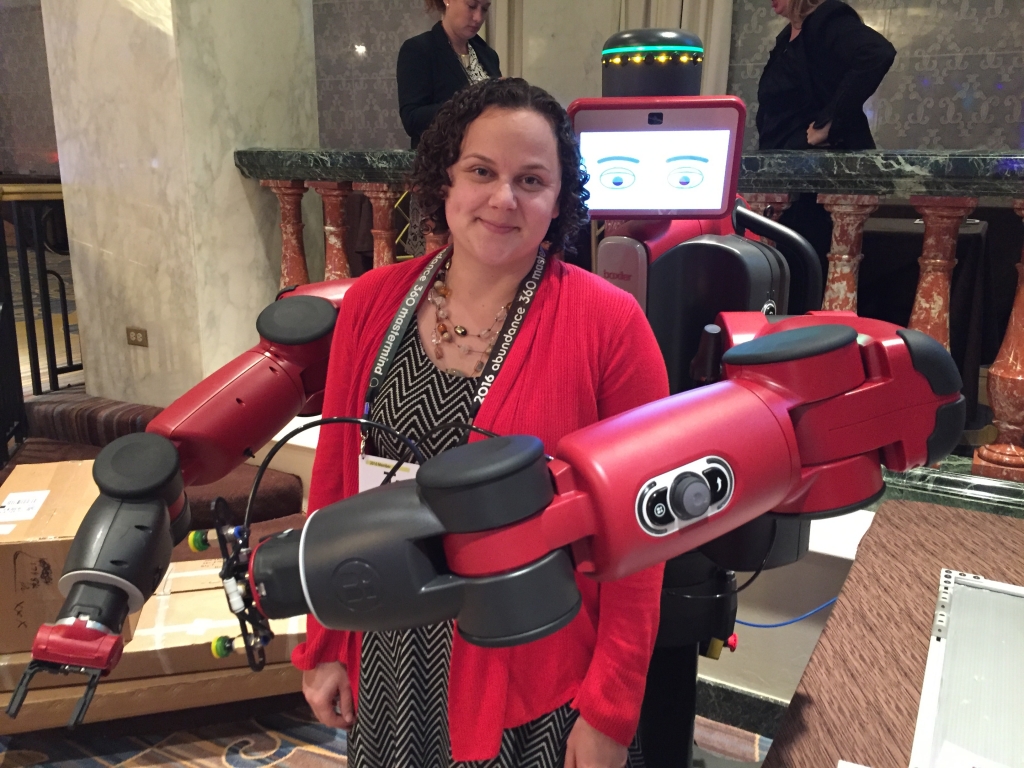I saw drones create 3D scans of buildings, was hugged by a robot that will make human labor on the assembly line irrelevant, and heard that nanotechnology will defeat cancer by 2033. I learned that 3D printers are printing human organs, which is great since deaths in car accidents — now the greatest source of organ donors — will be eliminated with self-driving cars.
During this amazing experience at the Abundance 360 summit, hosted by Peter Diamandis, author of Abundance: The Future Is Better Than You Think, I couldn’t help but wonder: where are the foundations in these conversations? Isn’t it our responsibility to go beyond understanding to creating the future? Change in the world and our communities is happening at a breathtaking rate, driven by access to infinite information and exponential increases in computer processing speeds. This accelerating rate of change makes the challenging work of doing good even more difficult. Foundations are trying to make the world a better place, but we are often using yesterday’s information to do so.
What if we could predict the future and prepare for the realities that will soon impact our communities? I believe it is our responsibility, as philanthropic leaders, to learn the skills necessary to understand and create the future. I’ve developed a three-step process to help philanthropic leaders escape from the busyness of today to create the communities of tomorrow.
Step One: Stop Loving the Problem
We spend a lot of time in philanthropy admiring problems. This is evident in the many reports in my office at the Minnesota Council on Foundations on the racial opportunity gap in schools, the extent of climate change, and the number of homeless teenagers in my state.
Knowing the scope of an issue is helpful, but it is not the end. It is simply counterproductive to spend so much time and mental energy on understanding what isn’t working. Instead of thinking more deeply about a problem, the solution is often to skip it all together.
For many years foundations and philanthropists were concerned about the electric and telecommunications infrastructure that would be needed for Sub-Saharan Africa — an infrastructure that is expensive to build and hard to maintain, but was thought critical to quality of life.
Cellular phones allowed Africa to completely skip the problem. Mobile Telephone Networks, a South-Africa based telecommunications company, provides phone service to emerging markets, and they bring electricity via generators with them as they expand. With a cell phone in your hand, you now hold a personal computer, a bank, and access to market prices, education, and health care. The problem wasn’t building the infrastructure. It was ensuring that communities had access to the benefits of that infrastructure.
Sometimes the problem we are focused on isn’t the problem at all, so skip it and think of what the problem would look like if it was solved. It might bring you to new solutions.
Step Two: Look
You can’t only be flexible when change comes, you need to anticipate the change and prepare for it because a problem can be an opportunity if you can see it before it lands on your doorstep.
So how do you do this? Set aside five percent of your time, preferably in a single two-hour block per week, to think about what the issues or communities you care about will look like five to 50 years in the future. Also pay attention to trends in your field and innovations outside of your field that may have an impact. TED Talks are a wonderful resource for this.
There are also futurists that study megatrends and how they predict they will impact the world. Common megatrends include technological progress, environmental decline, and conscious capitalism. Spend some time thinking about what each may mean for your field of work.
Here’s how I think philanthropy may be impacted by these three megatrends:
Technological progress: If technology is getting exponentially cheaper and faster, how will that change the way that citizens are connected? We have already seen this trend in action with the Arab Spring and the Black Lives Matter movement. Will new voices be heard and is philanthropy prepared to hear those voices?
Environmental decline: As natural disasters become more common, how can philanthropy help communities prepare before disaster strikes? Are there residents who are less likely to receive storm warnings, especially in immigrant communities? Can philanthropy develop relationships proactively before these disasters happen?
Rise of conscious capitalism: People care about where they spend their money, and business owners care about the double bottom line of fiscal performance and social impact. We will see many more social entrepreneurs working on issues that have traditionally been under the domain of government, nonprofits, and philanthropy. What new solutions will they bring? Will we be at the same tables to talk about the solutions?
Step Three: Go
Abraham Lincoln said, “The best way to predict the future is to create it.” This may feel counterintuitive, but as a field we need to learn to fail faster. We need to quickly prototype or implement new ideas and ways of working on the issues we care about (see Step Two: Look). This will allow us to more quickly figure out what does and doesn’t work.
Then you need to share what you’ve learned with the field — the good, the bad, and the ugly. We can’t be afraid of failure; it is the only way that we will get to new, transformative solutions.
Dr. Paul Ylvisaker believed “philanthropy is society’s passing gear.” The car is getting faster and the visibility is a lot less clear, so let’s spend more time reading the map, so we can both predict and shape the future of our communities.

Trista Harris is a philanthropic futurist and the president of the Minnesota Council on Foundations, an organization that works actively to expand and strengthen a vibrant community of diverse grantmakers who individually and collectively advance the common good. MCF members represent three-quarters of all grantmaking in the state, awarding more than $1 billion annually.
Follow Trista on Twitter at @TristaHarris.


